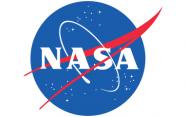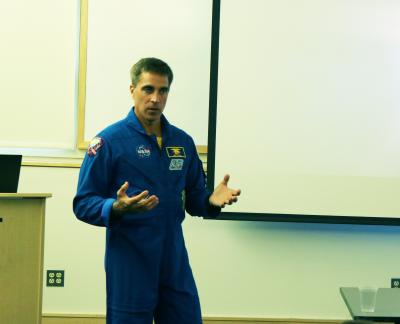Astronaut Chris Cassidy Talks With AGLP

Whether it’s handling everyday responsibilities or taking care of emergencies, the work of an astronaut depends on good teamwork and leadership. NASA’s Capt. Christopher J. Cassidy spoke to the SEAS Advanced Graduate Leadership Program (AGLP) Thursday about his experiences.
 Since he was selected by NASA in 2004, Cassidy has undertaken two space flights, STS-127 and Expedition 35. His first flight, in 2009, made him the 500th person in history to go out into space. His most recent flight, a six-month assignment in 2013, was aboard the Soyuz TMA‐08M. Cassidy was teamed with two Russian Cosmonauts on their trip to the International Space Station. He said astronauts don’t have a say in who’s assigned to their team, but that the different personalities are taken into consideration.
Since he was selected by NASA in 2004, Cassidy has undertaken two space flights, STS-127 and Expedition 35. His first flight, in 2009, made him the 500th person in history to go out into space. His most recent flight, a six-month assignment in 2013, was aboard the Soyuz TMA‐08M. Cassidy was teamed with two Russian Cosmonauts on their trip to the International Space Station. He said astronauts don’t have a say in who’s assigned to their team, but that the different personalities are taken into consideration.
“You get your assignment and your mission, and you go with it,” he said.
On board, a lot of the activities are similar to what people do on Earth – they watch TV, read books, look out the window (the cupola at the top of the International Space Station boasts an amazing view, Cassidy said). Daily intense workout sessions are important for maintaining bone density in the zero-gravity environment. Meals, made at NASA’s food lab, are pretty good. You can make phone calls but you can’t receive them.
As for getting around the Space Station, he said, floating is pretty much your only option.
“Floating in and of itself, is just fun,” he said. “We would have races at the end of the workday or on the weekend. The most fun one is ‘Who can go the farthest without hitting anything?’”
Spacewalks are a more demanding part of their work. They’re scheduled for about 6 and a half hours each (oxygen and other resources don’t last much longer), but the astronauts need to keep their space suits on for a total of 11 hours. If you accidentally let go of the safety tether during a spacewalk, some serious problems can happen.
“But spacewalks are really rewarding,” Cassidy said. “It’s you and your buddy, figuring out problems together.”
Cassidy has conducted six spacewalks. One of those was unplanned, undertaken to replace a pump controller box suspected to be the source of an ammonia coolant leak. Even more harrowing was his last spacewalk, which was cut short when his teammate Luca Parmitano detected water entering his helmet. It eventually filled up to the point that Parmitano couldn’t hear. Fortunately, he was able to get back safely.
“It’s a good lesson for you,” Cassidy said. “Things never get super-great really fast, but they can sure get super-bad really fast.”
Growing up in Maine, Cassidy said, he had no aspirations toward being an astronaut but gravitated to it after joining the military. His 10 years as a member of the U.S. Navy SEALs Team included two deployments to Afghanistan.
In addition to his talk and video of life in space, Cassidy took questions from the AGLP members. Asked about returning home, Cassidy said it takes him a little more than a month to get used to gravity and recover his balance.
Introducing Cassidy, SEAS Deputy Dean Vincent Wilczynski told the AGLP members that Cassidy’s experiences offer a great lesson in leadership.
“What does it mean to go into a small group, and your life is on the line because of the whole team behind you?” said Wilczynski, director of the AGLP. “What do you have to do to communicate with people literally from the other side of the world?”
Capt. Wayne Grasdock of Yale’s Naval Reserve Officers Training Corps (NROTC) Program, reiterated that Cassidy experiences – both in space and as a U.S. Navy SEAL – provided valuable leadership insights, especially when confronted with a decision for which there’s no set protocol.
“He has a capability where he stays very calm and collected,” he said, “and able to make the path easier for those who are behind him.”

